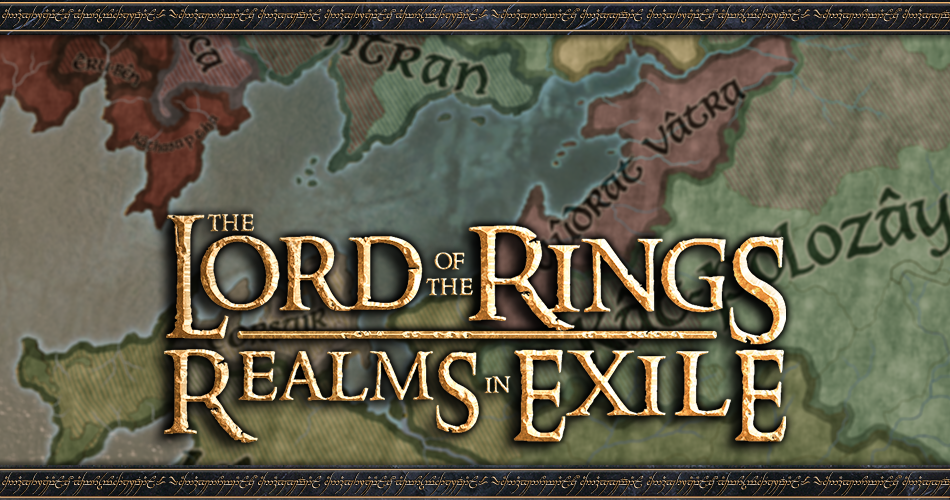Dev Diary #10: A Record of the Rây
By VectorMaximus
“Harshport, or the Bôzisha-Dâr in the native tongue, was a great city even before Captain Vëantur made his expedition east, or so we are told… Kalimmakil does argue that the foundations do not match the later style he could see, so he suspects the Bozishnarud simply built upon a pre-existing settlement… The Bozishnarud appear a mercantile people at heart, and the recommendation of the Guild is that we would counsel His Majesty open talks with them to discuss terms of trade in the port, as it appears a great hub of local commodities…”
- Report of Captain Ciryandil of the Guild of Venturers to the Council of the Sceptre and his majesty Tar-Súrion, S.A. 1446
Hello everyone, Vector here with a lore dev diary for one of the new areas of the south! So, fewer images, lots of text today, but on the whole a bit shorter! Today we’ll be looking at the history of the Rây, the heart of the Bôzisha-Mîraz and of Haradric civilization in Far-Harad, as well as its setup at our start.
The Elder Days
In the ancient days, the Rây was inhabited by small quantities of Avari. It was to this situation that the first men would come into the tale, the Honnin. The Honnin are akin to the Druedain of the north, sharing much the same physical characteristics. From the Avari of Rây, the Honnin learned much of medicine and folklore, and of divine revelation. And under the fading hand of their Avarin teachers, the Honnin proved themselves able craftsmen, particularly with stone, and began to establish settlements throughout the Rây. They named the land Sûzush Agkhôr, 'The Great Shining Land'. Although the Bozishnarud do not know it, almost every great city in the region, if excavated sufficiently, will likely show Honnin foundations. The great cities of the Bôzisha-Dâr, Tresti, and Al-Ramadi are just some of these ancient Honnin settlements.
In the last days of the First Age, another group of Men migrated into the region. These were Haradrim, the later Bozishnarud, and they were awed by the imposing stone edifices the Honnin had erected, and they settled alongside them. For a time, all was well, as the Bozishnarud learned the craft of the Honnin and made their own cities. However, in time, the Honnin, unlovely and stunted, grew to be distrusted and despised by their erstwhile pupils. As the forests of Harad turned to desert waste, more and more of the Haradrim poured into the Rây - and the Haradrim multiplied far faster than the Honnin did. So it was that by the time of the Númenórean return, the Honnin had tragically been forced into the Sûza Sûmar, protected by the jungle canopy, but much diminished in knowledge and prosperity from the days of old.
Imperial Númenor
So it was that the first encounters between the Bozishnarud and the Númenóreans happened in the year 1442 of the Second Age. The Guild of Venturers under Captain Ciryandil sailed up the Bay of Tulwang and docked at the Bôzisha-Dâr at the mouth of the Rîyesha. As the Númenóreans began to establish havens in Bellakar and An-Balkûmagân, the Rây was viewed as more valuable as a trade partner than a colony, and it was respected for its relative advancement and sophistication compared with other mainland societies.
As the power of Númenor waxed, it increasingly renegotiated the old trade agreements to favor itself, and eventually the entirety of the Rây was declared a protectorate and tributary (but not province) of imperial Númenor. The council of the Rây acknowledged Tar-Ciryatan as the Kralyi, or Great King, of the Rây. In turn, Tar-Ciryatan confirmed the council as his regents there, and decreed that so long as trade and tribute continued, there would be no Númenórean interference in the internal affairs of the Bôzisha-Dâr. ‘The Decree of Tar-Ciryatan’, while sometimes pushed, was never broken, fortunately for the Rây. Thus, the Rây experienced a period of peace and prosperity, albeit one taxed via tribute quite heavily.
After the Downfall
After the downfall of Númenor, the position of Kralyi was deemed empty by the Council of Regents, who proclaimed they would rule the realm as they had done for the past 1000 years. And this system largely worked, as the seven families of the council were of the highest nobility of the Rây. This noble oligarchy suddenly found themselves as kingmakers in the Bay of Tulwang, as Bellakar and An-Balkûmagân bickered over which ex-colony would be pre-eminent.
Rây would favor Bellakar on account of the long intermarriage between the colonial elites there and the Bozishnarud nobility, as well as the religious syncretism of Bellakar which aligned with the Bozishnarud pantheon. But not all were content with the status quo.
In T.A. 2194, adherents of the Cult of Vâtra led by Pôn Ifta staged a coup against the Council of Regents, seizing the Dâr. Religious radicals with a wildly different interpretation of the Kât-Polozây, they despised the Cult of Ladnóca, which was the pre-eminent goddess in the traditional religious orthodoxy. It resulted in a fundamental shift in Rây’s long-standing policies, as the traditional alliance with Bellakar lapsed and the Rây instead moved towards a cool neutrality. Pôn Ifta claimed the title of Kralyi, and proclaimed the Dynasty of the Sun (as Vâtra was the god of the sun).
Our Start
At our start date, the year 3000, Pôn Ifta’s descendants still rule the Rây, though their zealous fire has tampered to mere embers, as they have come to view trade and prosperity as more important than theological purity. Vatalinar is old, but still hale and healthy, and his line is secure in their control of the Dâr.
The hinterlands, particularly the city of Tresti, remain strong bastions of the traditional Kât-Polozây, and will brook no moves against their religious autonomy from the Dâr. The highlands of the Rây remain in the hands of the Narudbriyig, a hardy folk that do not take outside dominion lightly.
And on the easternmost border, Mardat, nephew of Sûladan of Haruzan, burns with a desire to bring the cult of Khäz-gramaze to pre-eminence in the prosperous Rây, covertly supported by agents of Mordor who view the Solar Dynasts as pawns no longer fulfilling their duties – to be a foe of Bellakar.
And in the dense jungle of the Sûza Sûmar, the Honnin dwell still, and perhaps might wish to reclaim their ancient homeland...
Faith and Culture Setup
As a capstone, a comprehensive look at the faith and culture setup of the region in the year 3000 of the Third Age.
I hope you're all looking forward to playing in the south! We are currently aiming for a release in advance of Royal Court, so before February 8th.
Mod of the Year
Finally as one last reminder, if you haven't already, please consider placing your vote for Realms in Exile in ModDB's Mod of the Year 2021. You've got just over a week left to get your vote in, so if you've had fun playing Realms and want a little way to say thank you, we'd be very grateful to have your support!
Top 100 - 2021 Mod of the Year Awards - Mod DB
Fellow Inklings: Join the Discussion
Not yet a member of the Realms Discord community? Join us here: Discord.gg
If you want to be pinged on Discord for when a new Dev Diary releases, go to the get-a-role channel and talk to Smeagol about getting yourself a new Loreseeker role. We swears you won't regrets it...











